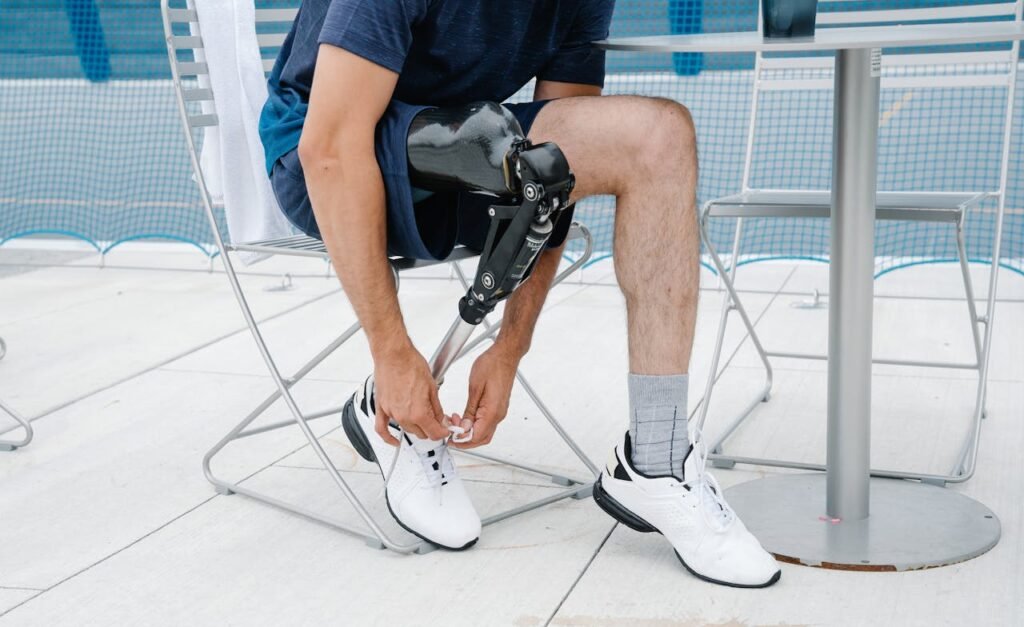Getting a prosthetic limb is one of the biggest turning points in life after limb loss. It’s more than a medical decision — it’s a step toward freedom, confidence, and independence. But once you’ve gone through your prosthetic trials and fittings, a common question arises: how soon can you start using it every day?
Some people expect to start right away. Others worry it might take months before their body adjusts. The truth is, it depends — not just on your prosthesis, but on you. Your healing, your comfort level, your confidence, and your consistency all play a role.
This article will help you understand that journey clearly. We’ll explore what happens between your final trial session and full-time daily use. You’ll learn what to expect during the adjustment period, how to train your body to adapt, and what small habits make all the difference in how fast you can get started.
At RoboBionics, we’ve helped hundreds of users across India make this transition smoothly — from their first fitting to walking, working, or gripping confidently in real life. Our goal here is to guide you with the same clarity and warmth we offer every person who walks into our clinic.
Understanding the Transition Phase
What Happens After the Final Trial
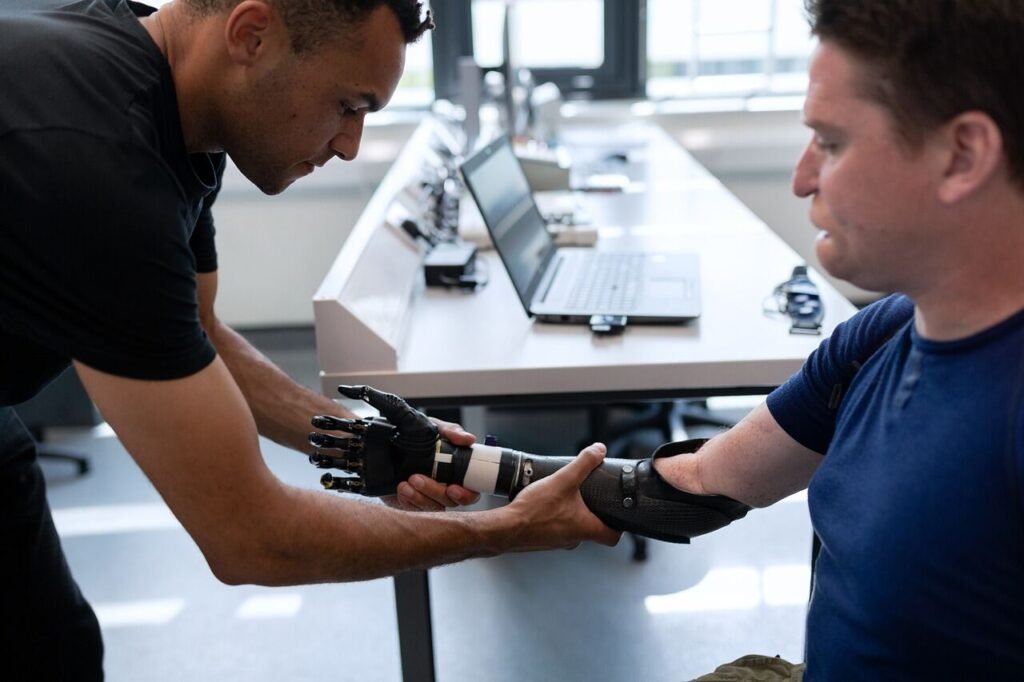
Once your last prosthetic trial session ends, your real journey begins. You’ve tested the fit, given feedback, and seen your prosthetist make final adjustments. Now, your prosthesis is ready to become a part of your daily life.
But before you wear it full-time, your body needs a short period to adapt. The skin on your residual limb has to get used to new pressure points. Your muscles must relearn how to balance and move with the prosthesis attached. This phase is not long, but it’s very important.
Your prosthetist will likely give you a schedule — when to wear it, how long each day, and what to do if you feel discomfort. Following this plan carefully helps you move faster toward full-time use.
The Role of Your Body in Adaptation
No two people adapt at the same speed. Some users start wearing their prosthesis daily within a week, while others may take a few weeks to feel ready. It depends on how your body responds to the new weight and alignment.
The muscles around your residual limb play a huge role here. They have to strengthen and learn to stabilize your body again. If you had your amputation recently, your muscles may still be healing — which can slow things slightly.
Think of this stage as teaching your body a new skill. Like learning to ride a bicycle, the first few attempts may feel awkward, but your balance improves with every try.
Why Patience Pays Off
Many users feel eager to start using their prosthesis right away — and that’s understandable. It represents independence. But rushing can lead to soreness or skin irritation if your limb isn’t fully ready.
Taking it slow during the first few days gives your skin time to toughen and your nerves time to adjust. It’s better to wear it for shorter periods consistently than to overuse it in one go.
Patience here doesn’t delay your progress — it ensures that once you do start using your prosthesis daily, you can do so comfortably and confidently.
Understanding the Psychological Transition
Wearing a prosthesis is not just a physical experience; it’s an emotional one too. For some people, the first time they use their prosthetic hand or leg feels amazing — for others, it can feel unfamiliar or even strange.
These feelings are normal. You’re adapting to something completely new. Trial sessions help with the technical side of things, but real-world use is where you rebuild trust with your body.
Allow yourself time to adjust emotionally as well as physically. Every step you take or every object you hold is progress — even if it feels small.
Working Closely with Your Prosthetist
Your prosthetist remains your biggest partner during this phase. They know how your prosthesis was built and how your body has responded to it. Keeping open communication with them helps you progress faster.
If something doesn’t feel right — even slightly — share it immediately. Small adjustments early on can save you from discomfort later. The goal is to reach a point where your prosthesis feels like part of you, not something you have to think about.
The First Few Weeks After Fitting
Wearing Time and Comfort
When you receive your prosthesis, your prosthetist will usually suggest a wearing schedule. In the first week, you might wear it for one to two hours a day. Then, the duration gradually increases as your comfort improves.
During this time, check your skin regularly for redness or irritation. If the redness fades within a few minutes after removing the prosthesis, it’s normal. But if it lingers or causes pain, stop wearing it and inform your prosthetist.
Building comfort gradually is the key. Your limb and prosthesis must learn to cooperate — and that takes a little time.
Building Muscle Memory
Every movement you make with your prosthesis sends new signals from your brain to your muscles. The more you practice, the stronger these signals become.
In the beginning, even simple actions like picking up a cup or taking a few steps may require focus. But with repetition, your brain starts treating those actions as natural. This is called muscle memory.
The faster your muscle memory builds, the faster you’ll move from occasional use to full-time wear. Short, daily practice sessions help more than long, tiring ones.
Managing Skin Sensitivity
Your residual limb is sensitive, especially if you’ve only recently healed from surgery. It’s normal to feel warmth, tightness, or slight pressure when you start using your prosthesis.
To protect your skin, keep the socket clean and dry. Always wear a clean liner or sock as recommended by your prosthetist. Good hygiene prevents rashes and keeps your skin healthy.
Over time, your skin becomes stronger and more resilient — and those early sensations fade completely.
Staying Relaxed During Movement
In the first few days, you may find yourself tensing your shoulders, arm, or back while using your prosthesis. This happens because your body is trying to stay in control.
Relaxation is key. When your muscles stay loose, your movements become smoother and more natural. If you notice tension, take short breaks, stretch, or practice breathing exercises.
Your physiotherapist can also guide you on posture and balance exercises that make daily use easier.
When Progress Feels Slow
It’s common to feel like progress isn’t happening fast enough. You might wonder why your prosthesis still feels awkward after a few days. But this stage is temporary.
Every time you wear your prosthesis, your brain and body are learning something new. The improvements may be small each day, but they build up quickly.
One morning, you’ll realize you’ve been using your prosthesis for hours without thinking about it. That’s the moment when you know you’ve crossed into true daily use.
Training for Daily Activities
Practicing Everyday Tasks
Once your comfort and control improve, it’s time to start using your prosthesis for real-world tasks. These activities train your coordination and help you adapt faster.
If you’re using a hand prosthesis, start with light tasks — holding a bottle, using utensils, or folding clothes. Gradually move to more complex actions like writing or carrying small items.
If you’re using a leg prosthesis, practice standing from a seated position, walking short distances, and climbing stairs with assistance. Every movement you master makes the next one easier.
Working with a Physiotherapist
Physiotherapy is an important part of your transition. Your therapist designs exercises that strengthen your residual limb and improve your balance. They also correct your posture to prevent strain.
For myoelectric prosthesis users, training includes practicing steady muscle signals for smoother control. For mechanical prostheses, it focuses on stability and endurance.
These guided sessions make your adaptation structured and safe.
Building Endurance
Daily use means you’ll be wearing your prosthesis for long hours — at work, outdoors, or while traveling. That requires endurance.
In the early weeks, your muscles may get tired faster. To build stamina, increase your wearing time gradually and take short breaks during the day.
Hydration, stretching, and proper nutrition also help your body adjust faster. Within a month or two, you’ll notice your endurance improving naturally.
Emotional Growth Alongside Physical Progress
As you learn to use your prosthesis more confidently, your mindset changes too. You stop thinking about what you can’t do and start focusing on what you can.
That mental shift is powerful. It helps you stay consistent even on days when progress feels slow. Surround yourself with supportive people — family, friends, or even other prosthesis users who’ve been through the same journey.
At RoboBionics, we’ve seen time and again that emotional strength often determines how quickly users reach full-time comfort. A positive outlook can make your progress twice as fast.
Reaching Full-Time Daily Use
How Long Does It Usually Take?
There isn’t one fixed timeline for everyone, but most users start wearing their prosthesis comfortably for most of the day within four to eight weeks after their final fitting.
Some people adapt faster — especially if they’ve been active before or have strong muscle control. Others may take longer, depending on their healing stage, limb condition, and emotional readiness.
What matters is consistency, not speed. Wearing your prosthesis every day, even for short periods, teaches your body to adjust faster than irregular use ever could.
Listening to Your Body
As you begin wearing your prosthesis for longer hours, pay close attention to what your body tells you. If you feel warmth, discomfort, or skin tenderness, take a break.
Your prosthetist designed your socket to distribute pressure evenly, but minor adjustments are sometimes needed as your limb changes shape. It’s natural — your body is still adapting.
The golden rule is simple: comfort leads to consistency. And consistency leads to confidence.
When You Start Forgetting You’re Wearing It
One of the best moments in this journey is when you catch yourself using your prosthesis naturally — reaching for a cup, walking across the room, or typing without thinking twice.
That’s when you’ve truly achieved daily use. Your body and mind have stopped treating your prosthesis as something external. It’s now just a part of you.
This phase usually arrives quietly. You may not notice it right away, but one day, you’ll realize you haven’t removed your prosthesis for hours — and you’re completely at ease.
Balancing Activity and Rest
Even after you reach full-time use, it’s important to maintain balance. Your residual limb still benefits from rest periods. Removing your prosthesis for short intervals lets your skin breathe and muscles relax.
During these breaks, inspect your skin for redness or marks and apply any recommended moisturizers. This simple routine keeps your limb healthy and your prosthesis feeling comfortable for years.
Think of rest as part of your success — not a setback.
How Emotional Confidence Shapes Physical Progress
It’s often said that your mind adapts faster than your body. In prosthetic use, the opposite can sometimes be true. You may move well physically but still hesitate emotionally.
Some people worry about using their prosthesis in public, fearing others might stare. Others hold back because they’re afraid of dropping things or tripping.
But confidence grows through experience. The more you use your prosthesis in everyday situations, the faster those fears fade. You’ll soon realize that most people aren’t watching — and even if they are, they’re usually inspired.
Confidence is what transforms movement into freedom.
Common Challenges During the Transition
Skin Sensitivity and Pressure Points
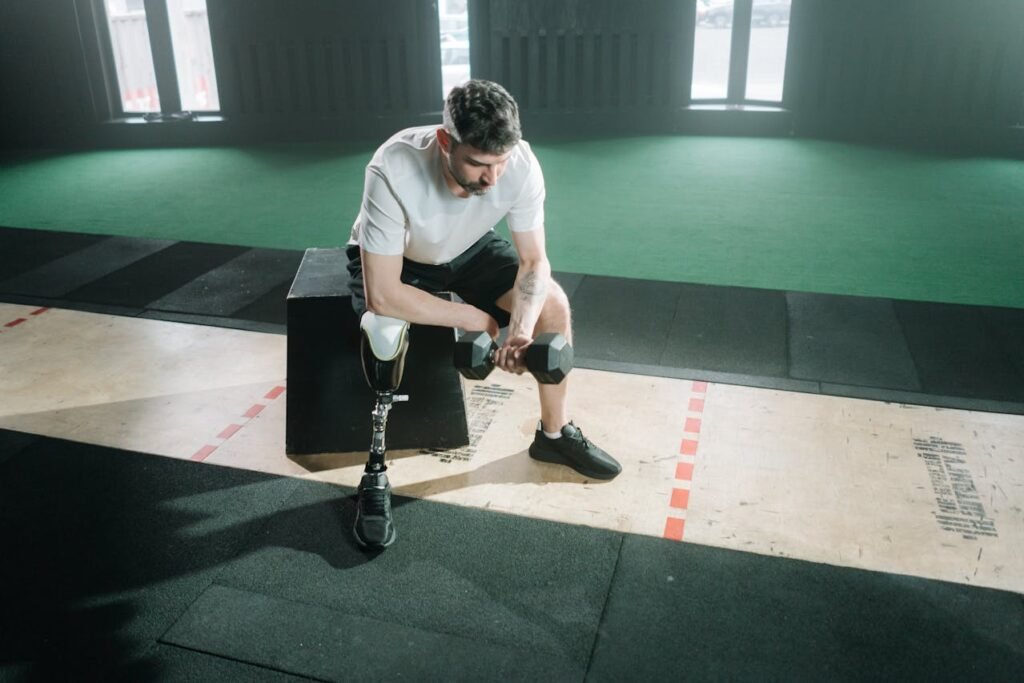
The most common challenge in the first few weeks of daily wear is skin sensitivity. Redness, warmth, or mild soreness can happen as your skin adjusts to contact with the socket.
This isn’t something to fear — it’s part of adaptation. Regular cleaning, proper fit, and using the right liner material all help. If discomfort lasts longer than a few hours, your prosthetist can make quick adjustments to relieve the pressure.
Never ignore ongoing pain or swelling. It’s your body’s way of saying it needs a small change.
Muscle Fatigue and Balance Issues
At first, using your prosthesis takes more energy than you expect. Your body is learning new ways to balance and move.
Mild muscle fatigue is normal, especially in your back, shoulders, or thighs (depending on your limb type). Over time, your body becomes stronger, and movement feels effortless.
Simple daily exercises recommended by your physiotherapist can speed up this strengthening process. In just a few weeks, you’ll notice that fatigue fades and endurance improves dramatically.
Adjusting to Weight and Movement
Modern prosthetics like the Grippy™ Bionic Hand are lightweight, but they still add new weight to your body. The first few days might feel uneven or heavy.
As your muscles adjust, this sensation disappears. Many users describe it as similar to wearing a watch or glasses for the first time — noticeable initially, but soon completely natural.
It’s all about giving your body time to rebalance itself around this new addition.
Emotional Frustration
Some users feel frustrated when progress seems slow. They compare themselves to others who adapted faster and start doubting their own progress.
But every body heals differently, and comparison only steals motivation. Instead, track your own improvements — how much longer you can wear it each day, how many tasks you can now do independently, or how much more confident you feel.
Those are your milestones, and they’re worth celebrating.
Technical Adjustments
Occasionally, small technical issues appear during early use — maybe your bionic hand doesn’t respond smoothly, or your mechanical limb makes slight noise when walking.
These are easy fixes. At RoboBionics, we encourage users to report any irregularities immediately. Our support team makes fine adjustments quickly, ensuring your prosthesis performs exactly as designed.
Never try to fix or modify anything yourself — even tiny screws or alignments require precision tools. Let your prosthetist handle it safely.
The Role of Rehabilitation and Training
Why Rehabilitation Matters

Wearing your prosthesis is one thing; mastering it is another. Rehabilitation bridges that gap. It’s where you learn balance, coordination, and control in real-life situations.
Rehabilitation also strengthens the muscles that support your prosthesis. For instance, upper-limb users work on shoulder and back muscles, while lower-limb users focus on core and hip stability.
Skipping this phase often leads to slower progress or unnecessary strain. Consistent training, even for a few weeks, speeds up adaptation more than anything else.
Types of Training Exercises
Training is always personalized, but it generally begins with gentle stretching and strengthening routines.
For bionic hand users, the exercises focus on controlling grip patterns and muscle signals. You’ll practice opening and closing your hand with precision, gradually moving from light to heavier tasks.
For lower-limb users, it includes walking practice, posture correction, and stair training. Every exercise is designed to rebuild confidence in your movements.
The goal isn’t perfection — it’s fluidity. You should move without thinking about mechanics.
The Gamified Rehabilitation Approach
At RoboBionics, we’ve developed a unique way to make training more engaging — our Gamified Rehabilitation App.
Instead of repetitive exercises, users play simple digital games that react to their prosthetic movements. It turns rehabilitation into a fun, interactive experience.
This approach not only builds control faster but also keeps motivation high. Users look forward to each session because it feels more like play than therapy.
Practicing Real-Life Scenarios
Rehabilitation doesn’t stop in the clinic. Your therapist will encourage you to try real-life scenarios at home — using your prosthesis to cook, type, lift groceries, or even play sports.
These daily-life tasks train your reflexes and build adaptability. The more you practice in real settings, the faster you’ll transition to full-time comfort.
Consistency turns practice into instinct.
Working as a Team
Your prosthetist, physiotherapist, and you form a team. Communication between everyone ensures every part of the process supports your progress.
If your therapist notices alignment issues, they’ll inform your prosthetist. If your prosthetist spots muscle weakness, they’ll recommend specific exercises.
This teamwork ensures every adjustment — physical or technical — moves you closer to daily independence.
Entering Everyday Life with Your Prosthesis
Using Your Prosthesis at Work
When you first return to work after getting your prosthesis, everything feels slightly new. You’re moving differently, handling tools or devices in new ways, and finding your rhythm again.
This stage is both exciting and challenging. Start by easing into your routine. If possible, talk to your employer or colleagues about your prosthesis and let them know you may need a few days to adapt to certain tasks. Most people are supportive once they understand your journey.
If you use a hand prosthesis, practice your daily tasks — typing, writing, handling papers, or lifting lightweight objects — in short sessions. If you use a leg prosthesis, stand and move at your own pace, taking breaks when needed.
Over time, your comfort and efficiency will improve naturally. Before long, you’ll find yourself performing your work as confidently as before — maybe even better, now that you have new focus and strength.
Adapting to Outdoor Activities
Stepping outside with your prosthesis brings a new sense of freedom. Walking through parks, shopping, or commuting gives you confidence in real-world situations.
Outdoor environments often bring small challenges like uneven ground, slopes, or stairs. These moments are great opportunities to strengthen your balance and coordination. If you’re a lower-limb user, your physiotherapist can teach you techniques for navigating such surfaces safely.
For upper-limb users, outdoor activities help refine control — carrying bags, opening doors, or holding small objects while moving. Each step outside is a lesson in trust — both in your prosthesis and in yourself.
The first few outings may feel cautious, but each one expands your comfort zone. In a few weeks, moving outdoors will feel completely natural.
Incorporating Exercise and Fitness
Many people worry about whether they can exercise with their prosthesis. The answer is yes — and you should. Physical activity helps keep your muscles strong and your balance stable.
Start small. Simple exercises like stretching, light cardio, or balance drills are perfect in the beginning. Once your body adapts, you can gradually move on to more dynamic activities like jogging, swimming (if your prosthesis is water-resistant), or sports-specific movements.
Your prosthetist can guide you on safe exercises that suit your prosthesis type. Remember, the goal is not just fitness but freedom of movement — feeling strong in every part of your body again.
Handling Social Situations
One of the most powerful milestones in this journey is becoming comfortable with your prosthesis in social settings. Meeting friends, attending gatherings, or interacting with new people can sometimes make users self-conscious in the beginning.
It’s natural to feel that way. But remember, most people are simply curious — and once they see your confidence, curiosity turns into admiration. You’re not just wearing technology; you’re wearing your resilience.
Some users choose to explain their prosthesis openly; others prefer not to mention it at all. There’s no right or wrong — only what makes you feel comfortable. The more you live confidently, the more others mirror that same comfort around you.
The Return of Independence
Using your prosthesis daily eventually leads to something greater than movement — independence. You’ll notice that you no longer wait for help to reach for things, carry groceries, or move around.
That freedom brings back a deep sense of dignity and pride. Many of our users describe this phase as “getting my life back.” It’s not about replacing what was lost — it’s about realizing what’s still possible.
Every independent action, no matter how small, is a symbol of your strength and perseverance.
Emotional Growth Through Daily Use
Accepting the New You

Transitioning to full-time prosthetic use is not only a physical journey but an emotional transformation. You’re adjusting to a new version of yourself — one that’s capable, confident, and strong.
In the early stages, you may still look at your prosthesis and see something mechanical. But soon, you’ll see it differently — as an extension of you, a tool that empowers rather than reminds.
Acceptance doesn’t happen overnight, but it grows through each success. Every time you achieve something new with your prosthesis, you’re rewriting your story — from limitation to empowerment.
Managing Doubts and Setbacks
Even the strongest individuals have moments of frustration or doubt. You might have days when your prosthesis feels uncomfortable or when progress seems slower than before.
During those times, remind yourself that adaptation isn’t a straight line. Every step, even the difficult ones, moves you forward. Reach out to your prosthetist or rehabilitation team whenever you feel uncertain — they’ll help you find your footing again.
You can also connect with other prosthesis users. Listening to their stories reminds you that every challenge is temporary and that success always follows persistence.
The Power of Routine
Once your prosthesis becomes part of your daily life, routine becomes your greatest ally. Setting a consistent pattern of use, care, and rest helps both your body and mind adjust seamlessly.
You’ll develop habits that make everything easier — charging your bionic hand at night, cleaning the socket in the morning, stretching before walks. These routines turn your prosthesis from a tool into a trusted companion.
When consistency replaces hesitation, confidence naturally follows.
Rediscovering Joy in Small Moments
One of the most beautiful things about adapting to a prosthesis is rediscovering joy in simple, everyday moments. The first time you hold a pen, open a bottle, or walk without thinking about balance — these moments mean everything.
They remind you that your prosthesis isn’t just restoring function; it’s bringing back experiences you missed. Each small victory carries deep emotional meaning.
At RoboBionics, we often hear from users who say they didn’t just get a prosthesis — they got their smile back. That’s the real measure of success.
Long-Term Adaptation and Lifestyle Integration
Adjusting to Long-Term Wear
As you move from months to years of use, your prosthesis becomes as natural as any other part of your body. But even long-term users must remember one rule — care is constant.
Your body keeps changing with time, and so does your limb. Weight changes, muscle growth, or natural wear on the socket can slightly affect fit. That’s why periodic check-ups are vital.
A quick appointment every few months ensures that your prosthesis remains as comfortable as it was on day one. Small maintenance today prevents big adjustments later.
Upgrading as Your Needs Grow
With continuous innovation in prosthetics, you may one day want to upgrade your device. Maybe you want improved grip patterns, longer battery life, or a lighter design.
At RoboBionics, we design every product with future upgrades in mind. Whether you’re using a mechanical or bionic model, new modules can be added without replacing your entire prosthesis.
Technology grows, and so can your comfort and performance. Each upgrade brings you closer to even more natural movement.
Keeping Your Skin and Limb Healthy
Long-term comfort depends greatly on how you care for your residual limb. Daily cleaning, gentle massage, and regular moisturizing help maintain healthy skin.
If you ever notice sensitivity or changes in texture, let your prosthetist know. Skin care and socket maintenance go hand in hand — when one is looked after, the other performs better.
Healthy habits make daily use effortless and pain-free.
Staying Connected to Your Support Team
Even after years of use, staying connected to your prosthetic provider is important. Life changes — and with it, your needs. Whether it’s an adjustment, a repair, or a new activity you’d like to try, your prosthetist can help make it happen.
Our team at RoboBionics stays in touch with users long after delivery. Many become friends, returning not for fixes but for updates, advice, or simply to share milestones. We believe care doesn’t end — it evolves with you.
Finding Strength in the Prosthetic Community
The Value of Shared Experience
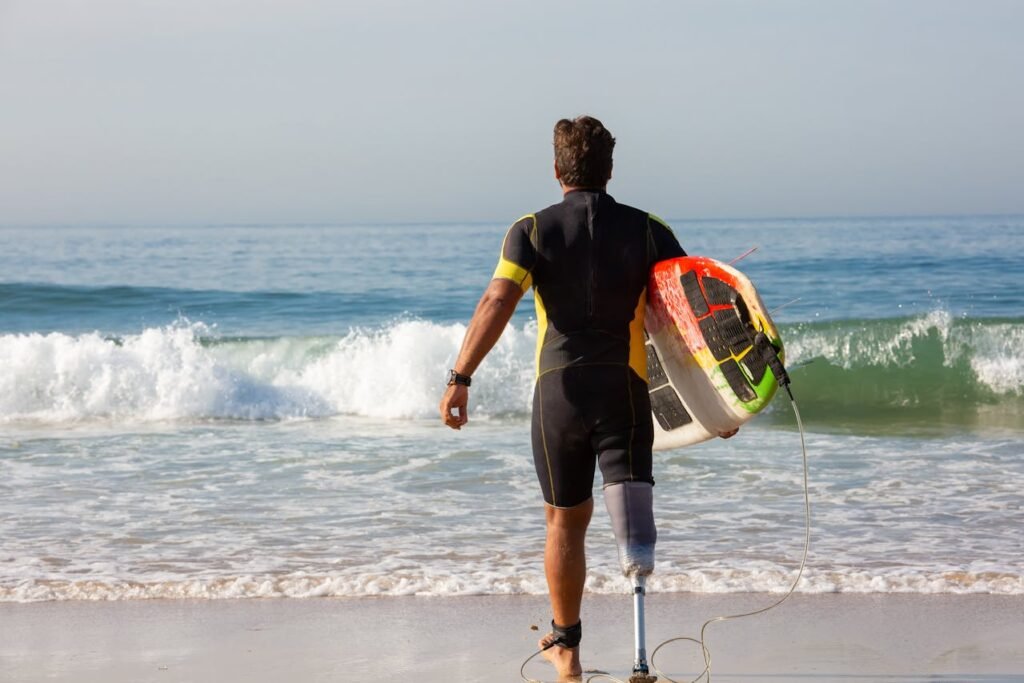
One of the most uplifting parts of the prosthetic journey begins when you connect with others who truly understand it. The prosthetic community is filled with people just like you — people who have faced uncertainty, found their rhythm again, and now live independently with strength and pride.
Hearing their stories brings reassurance. You realize that your small struggles are part of a bigger journey that many have walked before. You also begin to see how far you’ve come — something that’s easy to overlook when you’re living it every day.
Sharing experiences, advice, and encouragement gives you strength. It reminds you that your challenges are temporary, but your determination is permanent.
Learning from Others’ Journeys
Every person’s adaptation timeline is different, but the lessons learned are often similar. Someone might tell you how they learned to walk on uneven terrain without fear, or how they regained confidence holding objects in public.
These stories aren’t just inspiring — they’re practical. They offer tips that help you avoid common mistakes, make adjustments faster, and find motivation during slow phases.
At RoboBionics, we often connect new users with experienced ones. These conversations help newcomers feel supported, seen, and understood. They also build a chain of compassion that keeps growing stronger with every new user.
Giving Back to Others
As you continue using your prosthesis and gain confidence, you may find yourself becoming the person others look up to. Sharing your own experience — the trials, the patience, the victories — can give someone else the courage to start their own journey.
Some users visit hospitals, others volunteer at rehabilitation camps, and many simply offer words of encouragement to someone struggling with the early days of adjustment.
By giving back, you don’t just inspire others — you reinforce your own strength. Each time you help someone, you remind yourself of how far you’ve come and how capable you’ve become.
Staying Motivated for the Long Run
Setting Personal Milestones
Even after you’ve adapted fully to your prosthesis, setting new goals helps you stay motivated. Maybe you want to walk a longer distance, try a sport, cook with both hands, or travel solo again.
Small, achievable milestones keep the excitement alive and show you that growth never stops. Every goal you reach renews your confidence and strengthens your bond with your prosthesis.
Write your milestones down. Track them. Celebrate them. Progress feels even more rewarding when you can look back and see how far you’ve come.
Staying Positive During Challenges
No journey is free of obstacles. Some days, your prosthesis might feel heavier or less responsive. Other days, you might simply feel tired. When that happens, remind yourself that it’s okay to pause. Resting doesn’t mean quitting.
A positive mindset doesn’t mean ignoring frustration — it means believing you can overcome it. Speak kindly to yourself, seek help when needed, and focus on what’s working rather than what’s not.
Your perseverance is what brought you this far; it will keep taking you forward.
Involving Family and Friends
Your family and friends play a huge role in your adaptation. They see your progress, cheer for your wins, and often help when things feel tough.
Involving them in your journey makes everything easier. Show them how your prosthesis works, teach them how to help if needed, and let them share in your excitement when you master new skills.
Their encouragement fuels your confidence. And the more they see your comfort and independence grow, the more they believe in your strength too.
Keeping a Gratitude Mindset
Gratitude is one of the most powerful motivators. Every time you use your prosthesis — to work, to write, to move — take a moment to acknowledge what that means.
You’ve regained something precious: control over your life. That realization can turn ordinary days into moments of pride.
Gratitude shifts your focus from what you’ve lost to what you’ve gained — and that simple shift keeps your spirit strong for the long run.
Why RoboBionics Is the Right Partner for Your Journey
Built in India, Made for You
At RoboBionics, our mission has always been clear — to create world-class prosthetic solutions that are advanced, affordable, and accessible for everyone.
Unlike imported prosthetics that cost up to ₹10 lakh or more, our flagship Grippy™ range brings cutting-edge technology at a fraction of the cost — between ₹2.15 and ₹3 lakh.
Every prosthesis is built with precision, using over 60 Indian-manufactured components. This not only supports local innovation but also ensures faster service, better availability, and long-term reliability.
Your prosthesis is made for your lifestyle, your comfort, and your independence.
Technology That Feels Human
Our Sense of Touch™ technology gives users the ability to feel again — to sense pressure, texture, and weight. That’s what makes Grippy™ prosthetics truly special. They don’t just look advanced; they feel natural.
Each product we design is tested and refined to ensure it responds intuitively to your muscle signals, helping movements feel smooth and effortless.
This is where engineering meets empathy — where technology serves the human spirit.
Continuous Support You Can Count On
Your relationship with RoboBionics doesn’t end when you receive your prosthesis. We stay with you throughout your journey — offering adjustments, servicing, and even virtual consultations for your convenience.
Whether you live in a major city or a smaller town, our expanding network of partner clinics across India ensures that help is always nearby.
Our users often say it’s our care and commitment that make the biggest difference — not just our devices. And we’re proud of that.
Making Advanced Prosthetics Affordable
We believe financial concerns should never stop someone from living a full life. That’s why we offer flexible EMI options for all our prosthetic products.
You can start using your prosthesis immediately and pay in easy installments that suit your budget. Every EMI plan is transparent, with no hidden costs — because trust is as important as technology.
Our goal is simple: to make sure every person who needs a prosthesis can afford one without compromise.
Where Innovation Meets Compassion
RoboBionics is more than a company. It’s a team of dreamers, engineers, and medical professionals who believe in the power of human potential.
We’ve seen firsthand how the right prosthesis transforms lives — from helping someone return to work to giving a child the ability to play again. Each story drives us to do more, build better, and reach further.
When you choose RoboBionics, you’re not just choosing a prosthesis — you’re choosing a partner who cares about your comfort, your progress, and your future.
Taking the First Step Toward Your New Beginning
Where to Begin
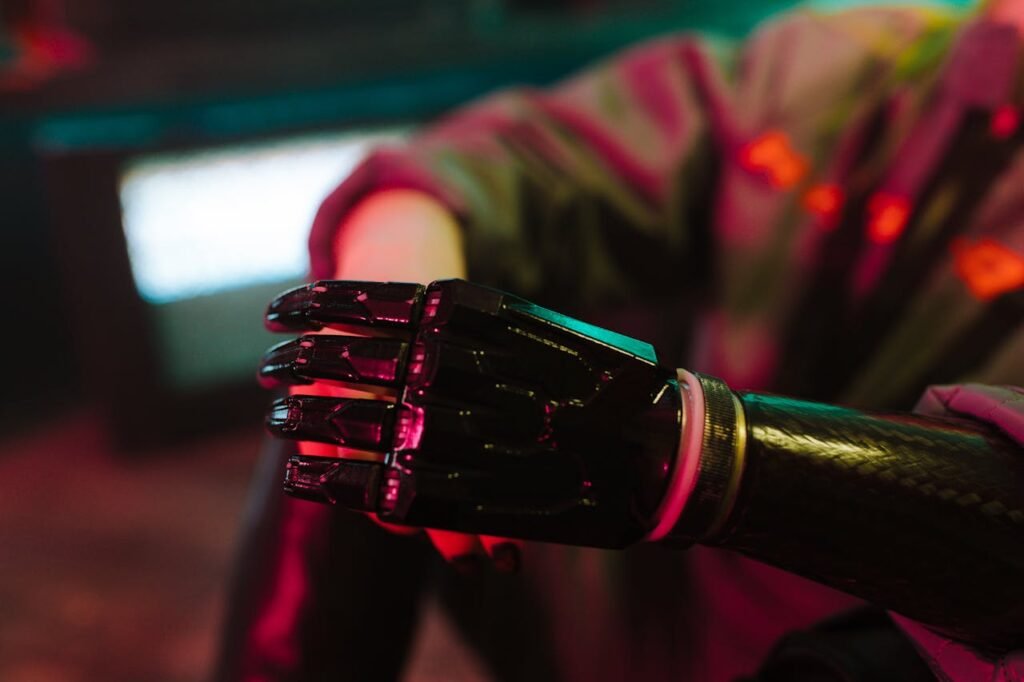
If you’ve completed your prosthetic trial or are about to start, this is the perfect time to plan your next step. Talk to our team about your fitting schedule, delivery timeline, and payment options.
We’ll walk you through each stage — clearly, patiently, and at your pace. You’ll know what to expect at every turn, from manufacturing to fitting to full-time use.
You can book your consultation easily at www.robobionics.in/bookdemo.
What Awaits You
Every new prosthesis we deliver marks the start of a new life story. The first day you use it may be filled with small challenges, but within weeks, those challenges turn into triumphs.
You’ll hold, move, and live with a confidence you may have thought was gone forever — and realize that your journey isn’t about what you’ve lost, but what you’ve regained.
Your prosthesis is more than a device; it’s proof of your resilience.
The RoboBionics Promise
We build our prosthetics with precision, but we serve with heart. From the first demo to your lifelong care, we’ll be there — ensuring your journey from trial to daily use is smooth, supportive, and empowering.
You’ve already taken the hardest step — deciding to move forward. Now, let us walk beside you for the rest of the journey.
Start your next chapter today. Visit www.robobionics.in/bookdemo to take your first confident step toward a life without limits.



